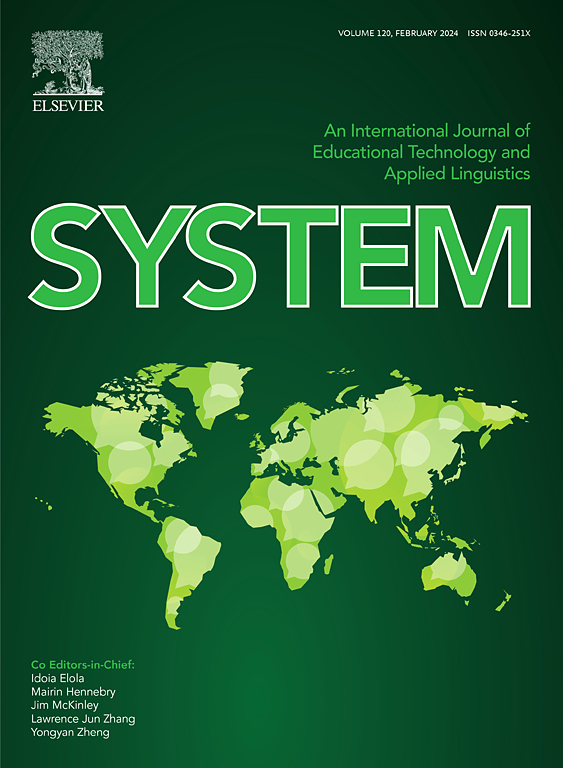不同会话生成式人工智能聊天机器人对 EFL 学习者的影响:对交流意愿、外语口语焦虑和自我认知交际能力的分析
IF 4.9
1区 文学
Q1 EDUCATION & EDUCATIONAL RESEARCH
引用次数: 0
摘要
基于交互假设,本研究探讨了不同会话生成人工智能(GenAI)聊天机器人对英语作为外语(EFL)学习者的交际意愿(WTC)、外语口语焦虑(FLSA)、自我感知交际能力(SPCC)和口语表现的影响。我们招募了三组中国本科生:对照组(CG,33 人)和两个实验组(EG1,33 人;EG2,33 人)。对照组在口语课上与老师和同学互动。相比之下,EG1 与一个名为 Typebot 的基于文字和语音的 GenAI 对话聊天机器人进行互动,而 EG2 则与一个名为 D-ID Agent 的 GenAI 对话聊天机器人进行互动,该聊天机器人具有文字和语音互动功能,并配有类人化身。使用多层次建模进行的定量分析显示,与 CG 相比,EG2 在 WTC 和 SPCC 方面有显著改善,FLSA 水平也明显下降。不过,前后的口语测试结果显示,各组的口语表现没有明显差异。来自半结构式访谈的定性数据支持了这些发现,强调了类人化身提供的身临其境的学习体验和情感支持。这些结果表明,视觉化身的 GenAI 聊天机器人能有效增强语言学习过程中的情感体验。这项研究为语言教育工作者在语言教学中整合 GenAI 技术提供了实用的见解,强调了类人化身在营造更具吸引力和支持性的学习环境方面的益处。本文章由计算机程序翻译,如有差异,请以英文原文为准。
The impact of different conversational generative AI chatbots on EFL learners: An analysis of willingness to communicate, foreign language speaking anxiety, and self-perceived communicative competence
Based on the Interaction Hypothesis, the study investigates the impact of different conversational Generative Artificial Intelligence (GenAI) chatbots on English as a Foreign Language (EFL) learners’ willingness to communicate (WTC), foreign language speaking anxiety (FLSA), self-perceived communicative competence (SPCC) and speaking performance. Three groups of Chinese undergraduate students were recruited: a control group (CG, N = 33) and two experimental groups (EG1, N = 33; EG2, N = 33). The CG interacted with the teacher and classmates during the speaking class. In contrast, EG1 interacted with a text- and voice-based conversational GenAI chatbot called Typebot, while EG2 engaged with a conversational GenAI chatbot that featured both text and voice interaction along with human-like avatars named D-ID Agent. Quantitative analysis using multilevel modelling revealed that EG2 showed significant improvements in WTC and SPCC and a notable reduction in FLSA levels compared to CG. However, the pre- and post-speaking test results showed no significant differences in speaking performance across the groups. Qualitative data from semi-structured interviews supported these findings, highlighting the immersive learning experience and emotional support provided by the human-like avatars. These results suggest that visually embodied GenAI chatbots can effectively enhance the emotional experience during the language learning. The study provides practical insights for language educators on integrating GenAI technologies in language teaching, emphasising the benefits of human-like avatars in fostering a more engaging and supportive learning environment.
求助全文
通过发布文献求助,成功后即可免费获取论文全文。
去求助
来源期刊

System
Multiple-
CiteScore
8.80
自引率
8.30%
发文量
202
审稿时长
64 days
期刊介绍:
This international journal is devoted to the applications of educational technology and applied linguistics to problems of foreign language teaching and learning. Attention is paid to all languages and to problems associated with the study and teaching of English as a second or foreign language. The journal serves as a vehicle of expression for colleagues in developing countries. System prefers its contributors to provide articles which have a sound theoretical base with a visible practical application which can be generalized. The review section may take up works of a more theoretical nature to broaden the background.
 求助内容:
求助内容: 应助结果提醒方式:
应助结果提醒方式:


